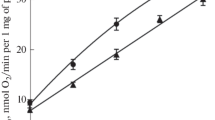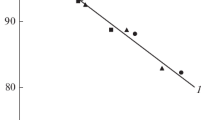Abstract
The oxidation of NADH by mouse liver plasma membranes was shown to be accompanied by the formation of H2O2. The rate of H2O2 formation was less than one-tenth the rate of oxygen uptake and much slower than the rate of reduction of artificial electron acceptors. The optimum pH for this reaction was 7.0 and theK m value for NADH was found to be 3×10−6 M. The H2O2-generating system of plasma membranes was inhibited by quinacrine and azide, thus distinguishing it from similar activities in endoplasmic reticulum and mitochondria. Both NADH and NADPH served as substrates for plasma membrane H2O2 generation. Superoxide dismutase and adriamycin inhibited the reaction. Vanadate, known to stimulate the oxidation of NADH by plasma membranes, did not increase the formation of H2O2. In view of the growing evidence that H2O2 can be involved in metabolic control, the formation of H2O2 by a plasma membrane NAD(P)H oxidase system may be pertinent to control sites at the plasma membrane.
Similar content being viewed by others
References
Andrea, W. A. (1955).Nature (London),175 859–860.
Badwey, J. A., and Karnovsky, M. L. (1979).J. Biol Chem. 254 11,530–11,537.
Boveris, A., and Chance, B. (1973).Biochem. J. 134 707–716.
Boveris, A., Martino, E., and Stoppani, A. O. M. (1977).Anal. Biochem. 80 145–158.
Boveris, A., Oshino, N., and Chance, B. (1972).Biochem. J. 128 617–630.
Briggs, R. T., Drath, D. B., Karnovsky, M. L., and Karnovsky, M. J. (1975).J. Cell Biol. 67 566–586.
Crane, F. L., Goldberg, H., Morré, D. J., and Löw, H. (1979).Sub-Cell. Biochem. 6 345–379.
Crane, F. L., and Löw, H. (1976).FEBS Lett. 68 153–156.
Crane, F. L., MacKellar, W., Morré, D. J., Ramasarma, T., Goldenberg, H., Grebing, C., and Löw, H. (1980).Biochem. Biophys. Res. Commun. 93 746–754.
Czech, M. P., Lawrence, J. C., Jr., and Lynn, W. S. (1974).J. Biol. Chem. 249 5421–5427.
De Chatelet, L. R., Shirley, P. S., McPhail, L. C., Huntely, C. C., Muss, H. B., and Bass, D. (1977).Blood 50 525–535.
Eckman, J. R., and Eaton, J. W. (1979).Nature (London) 278 754–756.
Etkin, N., and Eaton J. (1975). InErythrocyte Structure and Function, Vol. 21, G. J. Brewer, ed., A. R. Liss, New York, pp. 9–232.
Fee, J. A. (1980). InMetal Ion Activation of Dioxygen, T. G. Spiro, ed., Wiley, pp. 209–237.
Friedman, M. J. (1979).Nature (London) 286 245–247.
Gayda, D. P., Crane, F. L., Morré, D. J., and Löw, H. (1977).Proc. Indiana Acad. Sci. 86 385–390.
Gillette, J. R., Brodie, B. B. and La Du, B. N. (1957).J. Pharmacol. Exp. Ther. 119 532–540.
Goldenberg, H., Crane, F. L., and Morré, D. J. (1979).J. Biol. Chem. 254 2491–2498.
Goldenberg, H., Morré, D. J., and Crane, F. L. (1977).J. Cell Biol. 75, 209a.
Goldstein, I. M., Cerqueira, M., Lind, S., and Kaplan, H. B. (1977).J. Clin. Invest. 59 249–254.
Hildebrandt, A. G., and Roots, I. (1975).Arch. Biochem. Biophys. 171 385–397.
Hidebrandt, A. G., Speck, M., and Roots, I. (1973).Biochem. Biophys. Res. Commun. 54 968–975.
Kuthan, H., TsuJi, H., Graf, H., Ullrich, V., Werringloer, J., and Estabrook, R. W. (1978).FEBS Lett. 91 343–345.
Loschen, G., Flohe, L., and Chance, B. (1971).FEBS Lett. 18 261–264.
Löw, H., and Crane, F. L. (1978).Biochim. Biophys. Acta 515 141–161.
May, J. M. and de Haen, C. (1979a).J. Biol. Chem. 254 9017–9021.
May, J. M., and de Haen, C. (1979b).J. Biol. Chem. 254 2214–2220.
McCord, J. M., and Fridovich, I. (1969).J. Biol. Chem. 6049–6055.
Menon, A. S., Meera Rau, Ramasarma, T., and Crane, F. L. (1980).FEBS Lett. 114 139–142.
Morré, D. J. (1973). InMolecular Techniques and Approaches in Developmental Biology, M. J. Chripeels, ed., Wiley, New York, pp. 1–27.
Mukherjee, S. P., and Lynn, W. S. (1977).Arch. Biochem. Biophys. 184 69–76.
Ramasarma, T., MacKellar, W., and Crane, F. L. (1980).Indian J. Biochem. Biophys. 17 163–167.
Segal, A. W., and Peters, T. J. (1976).Lancet 1 1363–1365.
Swaroop, A., and Ramasarma, T. (1981).Biochem. J. 194 657–665.
Thurman, R. G., Ley, H. G., and Scholz, R. (1972).Eur. J. Biochem. 25 420–430.
Turrens, J. F., and Boveris, A. (1980).Biochem J. 191 421–427.
Yunghans, W. N., and Morré, D. J. (1973).Prep. Biochem. 3 301–312.
Author information
Authors and Affiliations
Rights and permissions
About this article
Cite this article
Ramasarma, T., Swaroop, A., MacKellar, W. et al. Generation of hydrogen peroxide on oxidation of NADH by hepatic plasma membranes. J Bioenerg Biomembr 13, 241–253 (1981). https://doi.org/10.1007/BF00743203
Received:
Revised:
Issue Date:
DOI: https://doi.org/10.1007/BF00743203




